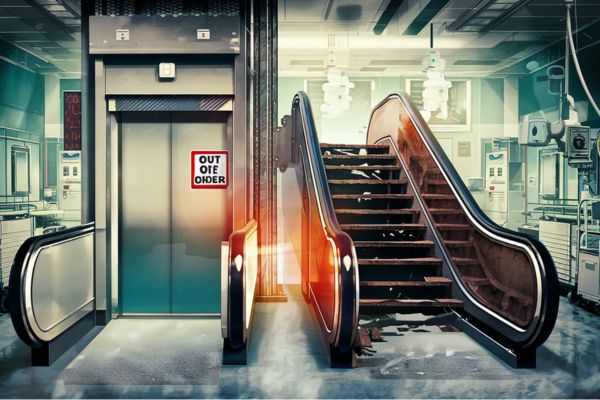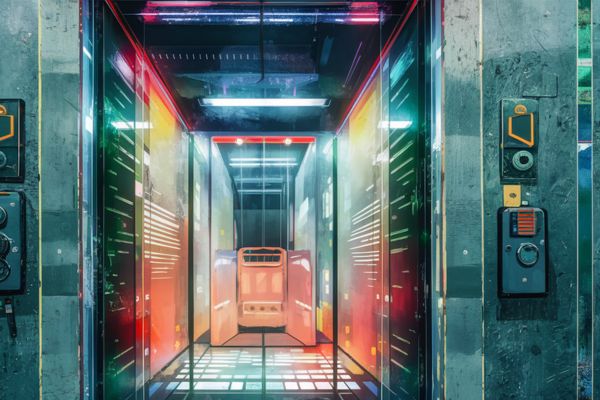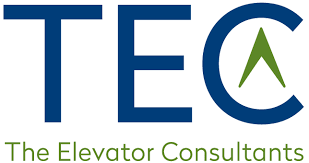Hospitals and medical facilities face distinct challenges in managing elevators and escalators, which are crucial for hospital operations and medical office buildings. Given the fragmented nature of hospital operations across multiple locations, including primary and remote medical office buildings, maintaining seamless elevator and escalator operations becomes challenging with locations, year of installation, usage, equipment type, and more.
Building engineers often need to be made aware of maintenance schedules or even the operational status of these critical elevator systems. This lack of communication and oversight can lead to unplanned downtime, affecting the hospital system.
Hospitals face several standard elevator and escalator issues, and they can take strategic measures to overcome these challenges by emphasizing the need for improved management, coordination, and technological integration.
What are the common elevator and escalator issues in hospitals
The operation of elevators and escalators in hospitals involves unique challenges that can impact the facility’s overall functionality.

Identifying Key Challenges
- Unscheduled Downtime: Elevators and escalators are vital in hospitals for staff and patient mobility and emergency responses, such as surgery. Unscheduled downtime, slow elevators, and problem elevators can severely disrupt operations and delay care.
- Inconsistent Maintenance Services: The vastness of hospital complexes, coupled with multiple external elevator service providers, can lead to inconsistent maintenance and service quality, risking staff, visitors, patient safety, and system reliability.
- Communication Gaps: The sprawling nature of hospital operations often results in a communication gap. Building engineers may need to be promptly informed about elevator malfunctions or maintenance schedules, complicating issue resolution and system management.
- Regulatory Compliance: Hospitals must adhere to stringent health and safety regulations, including those specific to elevator and escalator operations. Ensuring compliance across all facilities adds another layer of complexity to their management. Several authorities regulate elevators, including the Joint Commission and the Department of Public Health. Buildings must also comply with all elevator code requirements, including those set by the authority having jurisdiction.
Strategies for effective elevator management and resolution
Tackling these issues demands a comprehensive approach that enhances operational coordination, integrates advanced technologies, and adopts a proactive maintenance stance.

- Enhancing Communication and Coordination: Implementing structured technology communication channels and maintenance coordination mechanisms is crucial for synchronized operations across hospital facilities.
- Elevator Maintenance Database: Develop a system to oversee and coordinate maintenance activities, ensuring service quality and scheduling uniformity across all locations. This central hub can facilitate better planning, execution, and tracking of maintenance tasks. Since elevators are mission-critical, this system must be real-time with alerts.
- Real-Time Notification Systems: Introduce technology solutions that immediately notify relevant personnel about operational issues or maintenance needs. These systems ensure swift action, minimizing the impact on hospital operations and patient care, along with an elevator data hub.
Leveraging Technology For Improved Oversight
Adopting technology can significantly enhance the efficiency and reliability of hospital elevator and escalator operations.
- Advanced Elevator Service Monitoring Systems: Utilize sophisticated elevator and escalator monitoring software to gain real-time insights into system performance and maintenance needs. This visibility allows for better management decisions and proactive issue resolution.
- Data Analytics for Predictive Maintenance: Employ analytics tools to analyze operational data, predict potential failures, and schedule preventive maintenance. This approach helps avoid unexpected breakdowns and extends the lifespan of the systems.
Implementing Proactive Maintenance and Safety Measures
A proactive maintenance strategy, focused on regular checks and compliance audits, is essential for maintaining elevator and escalator safety and reliability.
- Regular Preventive Maintenance: Establish a routine preventive maintenance schedule that addresses potential issues before they escalate into major problems. Regular checks ensure the systems operate smoothly and comply with safety standards. These elevator and escalator schedules must be adhered to and monitored to ensure they are being completed.
- Safety and Compliance Audits: Conduct periodic spot-check audits to assess system safety and regulatory compliance. These audits help identify areas for improvement and ensure that elevator and escalator operations meet all required health and safety protocols. Technology can offer immediate notification of several safety violations in a cost-effective and timely manner.
Easy Elevator Management: ElevatorApp™

In the rapidly evolving landscape of vertical transportation, where buildings are reaching new heights and demands for efficiency and safety are paramount, traditional elevator management has faced its fair share of challenges. From unexpected costs to compliance hurdles and service provider issues, the journey through elevator maintenance has often been fraught with uncertainties and frustrations.
However, amidst these challenges, a beacon of innovation has emerged – introducing ElevatorApp™, a groundbreaking elevator monitoring software that promises to revolutionize how we manage elevators.
Gone are the days of being in the dark about your building’s elevator maintenance. ElevatorApp™ empowers building owners and property managers with real-time updates and comprehensive tools, firmly restoring control to their hands. Say goodbye to costly repairs and hello to efficiency and safety, as ElevatorApp™ equips you with the information needed to manage your elevator systems proactively.
So, What Sets ElevatorApp™ Apart?
Real-Time Updates and Control: ElevatorApp™ provides real-time updates and tools, allowing you to stay informed and take charge of your elevator management. No more surprises – just complete control at your fingertips.
- Comprehensive Platform: Our platform offers the information needed to ensure compliance, reduce costs, and enhance efficiency. From maintenance control program (MCP) information to service and callback data, ElevatorApp™ has you covered.
- Complete Visibility: With ElevatorApp™, transparency is key. Gain full visibility into your elevator service provider’s onsite work, with services logged in real-time and stored securely in the software’s database.
- Data Protection and Accessibility: Your data is our priority. ElevatorApp™ ensures that your information is protected and remotely accessible, allowing you to process it through numerous filters at your discretion.
- Industry Compliance: Rest assured that ElevatorApp™ follows all industry best practices to comply with the ASME A17.1 maintenance control program. With state-of-the-art software, we prioritize reliability and adherence to standards.
Ready to take control of your elevator management? Download the free ElevatorApp™ today and experience the future of vertical transportation wherever you are. Elevate your building’s potential with ElevatorApp™ – because the future is now regarding elevator management.
Addressing the challenges of multi-site operations
The fragmented nature of hospital operations poses specific challenges in managing elevators and escalators across multiple sites.
Streamlining Multi-Site Management
- Unified Service Provider Contracts: Where possible, negotiate contracts with elevator service providers that cover all hospital locations. This unified approach can lead to better service terms, easier management, and consistency in maintenance quality.
- Cross-Site Communication Platforms: Implement communication platforms connecting building engineers and maintenance teams across hospital sites. These platforms can facilitate sharing information, best practices, and alerts, fostering a cohesive operational strategy.
- Training and Empowerment: Train staff and engineers in essential elevator and escalator systems. Empowering local teams to know the nuances of the elevator industry gives staff the information needed to protect the hospital system.
Achieving reliable elevator and escalator operations in hospitals
Efficiently managing elevators and escalators in hospitals’ complex environments requires strategic planning, coordination, and technological integration. Hospitals can overcome the inherent challenges of their fragmented operations by adopting management practices, leveraging advanced service monitoring tools, and ensuring proactive maintenance.
Such measures ensure the reliability and safety of these critical systems and support the hospital’s mission to provide uninterrupted, high-quality patient care.
Have a Question About Elevators?
Talk to a Professional Elevator Consultant
FAQ ABOUT ELEVATOR AND ESCALATOR MANAGEMENT IN HOSPITALS
How Can Hospitals Effectively Manage Elevator Downtimes?
Effective management of elevator downtimes in hospitals requires advanced monitoring systems with real-time alerts. Hospitals should establish rapid response protocols and maintain clear communication channels to minimize the impact on operations and patient care. Implementing these strategies across the hospital system can be challenging. However, involving all stakeholders ensures a successful elevator management program.
What Role Does Central Coordination Play in Multi-Site Hospital Operations?
A central and joint team coordination plays a crucial role in ensuring consistency in maintenance practices, facilitating effective communication, and streamlining management efforts across multiple hospital sites, leading to improved system reliability and operational efficiency while saving costs.
How Can Technology Enhance Elevator and Escalator Safety in Hospitals?
Technology enhances safety by enabling real-time service monitoring, predictive maintenance, and instant communication, ensuring that elevator and escalator systems operate reliably and in compliance with safety standards, thereby safeguarding patients and hospital staff.
How can a hospital system implement an elevator management system?
Implementing an elevator management system requires all stakeholders to address each elevator and escalator issue. They then develop a plan for every unit. The process involves creating a strategy for each location, tailored to the building’s needs. This strategy considers budget, equipment, usage, and the expected life cycle of the units.
What is the return on investment for a hospital elevator management system?
The return on a hospital elevator management system can be as soon as immediate to a few months. A program is developed based on the condition of the elevators and escalators, stakeholder input, and current service, to name a few items.

